How to conduct a website audit
A comprehensive 5-week guide to reviewing your site

Last modified
If you have never audited your website, it is time to get started. A website audit gives you an aerial perspective on where you are, what’s holding you back, and how you can improve your online presence.
This process involves a review of traffic, ranking, SEO, content, usability and technical aspects of your web presence, allowing you to:
- Identify bottlenecks and pain points on your site
- Identify quick fixes or low-hanging fruit
- Identify any crawl issues, bugs or technical concerns
- Identify whether your site’s content strategy is working
- Identify whether the website is in need of a refresh
How often should you audit your website? The general consensus is that you should audit your site as frequently as you go for a dental checkup – that is, at least once a year, but ideally every 6 months.
Table of contents
Week 1: Website health check

The first step in your audit involves logging your website vitals so that you can compare trends over time.
Record your site’s domain authority
Domain authority is a scoring mechanism developed by Moz that predicts your site’s ranking potential (using a score from 1 to 100) based on its link profile – in other words, a site that earns a steady stream of high quality links from a variety of sources will grow in domain authority over time. Wikipedia, for example, has more than 5 million inbound links and a resultant domain authority of 97.
To log your site’s domain authority, use Moz’s free domain analytics tool. Make a note of the number of linking root domains (i.e. the number of domains that link to your site) as well as the number of keywords your website ranks for. Log the same set of stats for your major competitors e.g.:
| Your score | Competitor A | Competitor B | Competitor C | |
| Domain authority | 23 | 35 | 54 | 71 |
| Linking root domains | 280 | 512 | 3,400 | 19,500 |
| Ranking keywords | 585 | 44 | 380 | 10,600 |
In the example above, we can see that the number of linking root domains has a direct impact on domain authority.
Hint: Algorithmic changes may affect domain authority scores over time. For this reason, domain authority should never be used as an absolute score to measure the efficacy of your SEO efforts. Instead, this score should only be used as a comparative metric to benchmark your site against those of your direct competitors.
Log traffic trends over time
A look at long term traffic trends will help you determine whether your site’s content strategy is working. If you have an effective content strategy in place, your website traffic should be growing by at least 10-20% year-on-year.
Log into to Google Analytics (Audience > Overview) and review traffic trends over a three-year period. Use the date drop down on the top right to adjust the time parameters and set the toggle buttons below to monthly view:
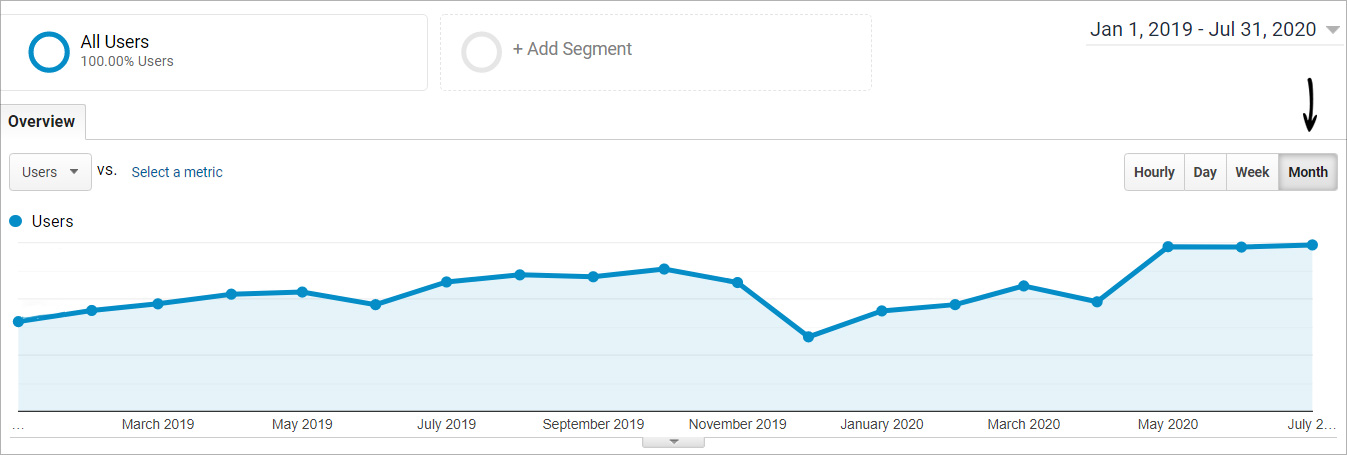
Log traffic stats for each year and make a note of seasonal highs and lows which may skew results. In fact, for most B2B sites we recommend discarding December stats entirely and dividing the remainder annual traffic total by 11 to get to your average monthly traffic:
| 2022 | 2021 | 2020 | |
| Average monthly traffic (divide total annual traffic by number of months so far) | 140,080 | 120,110 | 102,860 |
| Growth compared to previous year | 17% | 17% | 11% |
| Highest traffic month | May 2020 | May 2019 | Oct 2018 |
| Lowest traffic month | Apr 2020 | Dec 2019 | Dec 2018 |
Any significant dips in traffic warrant further investigation (see Identify crawl issues below). If your website is not hitting traffic targets, it is time to reassess your site’s content strategy.
Assess your website performance in terms of its goals
Next, make a list of the high-level business goals for your site – the raison d'être of your online presence. This could cover:
- Position your firm as an expert in its field
- Drive a steady stream of leads to the firm
- Sell products or subscriptions
- Attract the best recruits
- Build a community of [X]
- Serve as a hub for connecting [X] to [Y]
- Deliver industry leading insight relating to [X]
Give each goal a score from 1 out of 10 in terms of how you think the site is currently performing and note areas for improvement e.g.:
| Goals | Rating out of 10 | Room for improvement |
| Generate contact form enquiries | 5/10 | We receive 150 leads to the site every month, but only 10% of those leads are a good match for our firm. |
| Position our firm as an expert in cyber security | 6/10 | Prospective clients see us as experts in this field, but press and industry coverage has been limited so far. |
| etc | etc | etc |
| Aggregate score | 5.5/10 |
Calculate your site’s aggregate goal performance score and share these notes with your web developers. Results from this exercise should feed into your overall design and content strategy, as well inform future website revamp cycles.
Hint: If you have not already done so, set up goals (such as contact form completion) in Google Analytics so that you can keep track of conversion rates across the major assets on your site.
Log your best and worst performing content
To review your best performing content, log in to Google Analytics and review Behaviour > Site Content > All pages. Set the time period to the last 12 months to give you a broad data set.
Make a note of your best performing news, insights or blog pages (in terms of pageviews) and review them with the following questions in mind:
- What makes these posts successful? Are there any characteristics (such as post structure or subject matter) that make them stand out?
- Can the content be improved to make the posts rank even higher (e.g. by updating text or embedding related media, graphics or stats)?
- Can you create additional assets on your site to tackle related topics?
Next, click on the pageviews tab to sort results by the lowest performing content. Review low performing news, insights or blog content and see whether you can:
- Improve or update the content
- Combine content from low performing posts into other existing posts
- Remove these posts altogether from your site
It may sound counter-intuitive, but the removal of low performing news content can actually improve your site’s overall rankings. Ahrefs, for example, discovered that the expiration of 200 low-performing blog posts resulted in an 88% growth in search traffic.
Conclusion
You have now reached the end of your week 1 assessment and may have a list of issues you can start tackling with your web team. Week two will focus on a review of your brand’s performance in search engine results.
Week 2: Search audit

The way your brand performs in search engine results affects site traffic and conversions.
Branded search audit
Start your search audit with a branded search. Access Google and enter your company name but do not hit enter. A drop down should appear displaying popular user queries relating to your brand name.
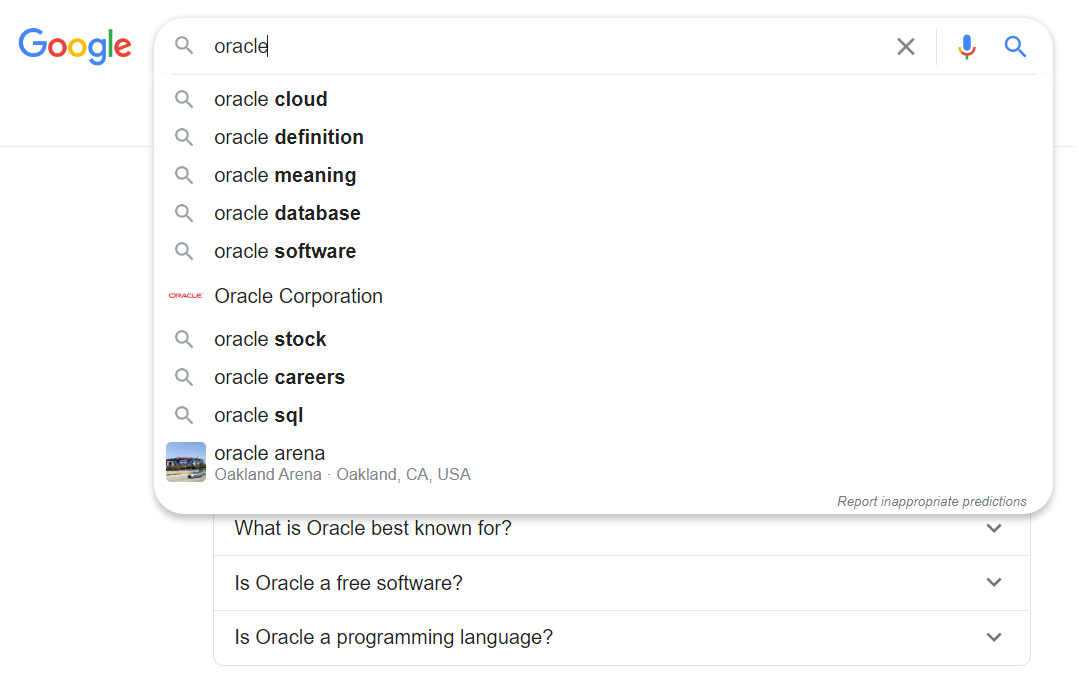
Assess whether you have content on your site that adresses these particular queries. If not, make a note of content gaps and add these to your content plan.
Next, repeat the step above but include “Does” and “Is” before your brand name:
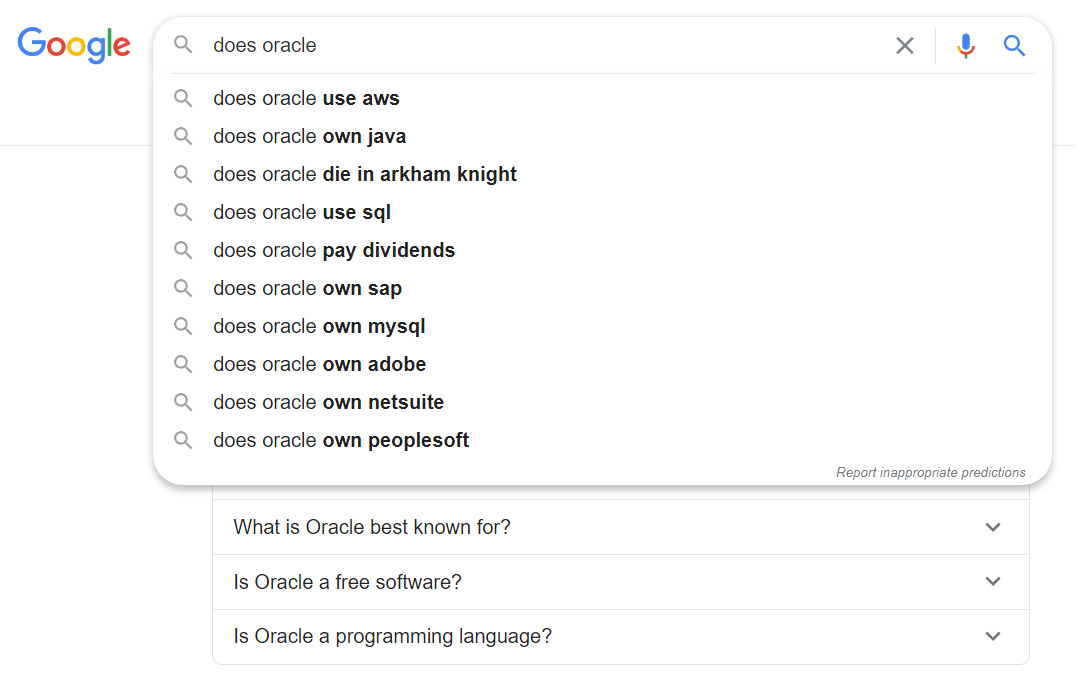
Does your website display as the first result for these queries? If not, make a note of top queries and add these to your content plan.
Lastly, enter your brand name in Google and this time include the word “vs” after your brand name. This will give you an overview of other brands that users typically compare you to. Review search results for all the query options.
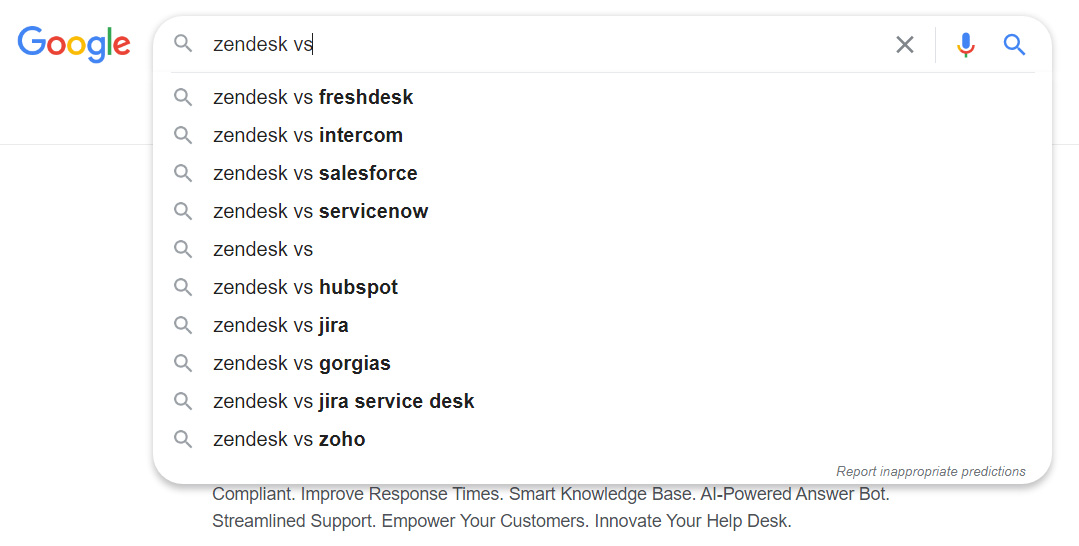
Zendesk, by way of example, has crafted clever content to address competitor comparison queries directly on its own site:

Platforms such as quora.com and industry-specific forums may also be useful places to address competitor comparison queries. The takeaway from this exercise is that you should own the conversation around your branded search queries.
SERPS review
Next, enter your brand name in Google and this time hit enter. Review the expanded search results. These tend to be most popular pages relating to your brand name:
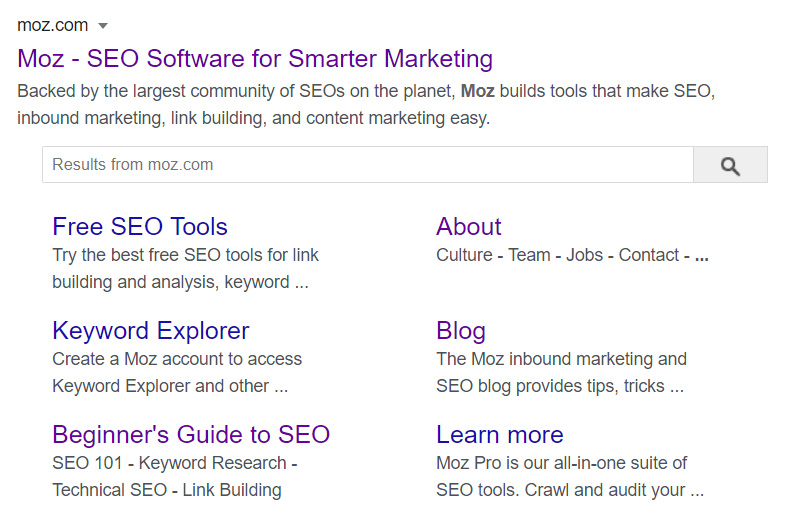
Review whether the page title tags and meta descriptions are compelling enough and whether they inspire action. Do they clearly describe what the page is about? If not, use your site’s CMS to refine meta tags for each key result above.
Hint: Enter site:yourdomainname.com on Google to review meta tags for all pages of your site. Well crafted meta tags can inspire clickthroughs even for lower ranking pages.
Target keywords audit
Next, list the 10 major keywords you would like to target in terms of search engine rankings.
Hint: Use Google’s AdWords Keyword Planner to double check that each target keyword has sufficient monthly traffic to warrant targeting.
List where you rank for each of these keywords on Google as well as the scope of pages on your site that have been written specifically to target that keyword (i.e. how many pages on your site are primarily about that topic containing that keyword in the title tag):
| Keywords | Your ranking on Google | Number of pages on your site that target that keyword |
| Website development | Under 20 | None |
| Website design | Under 20 | 2 |
| App development | 5th on Google | 12 |
Hint: Use Moz Pro to review on-page optimization for each of the pages above.
Identify critical content gaps and add these to your content plan. For example, if you would like to rank for the keyword “corporate law”, you could publish insights content such as the following:
- What is corporate law?
- The role of a corporate lawyer
- Corporate law fundamentals
- The basic rules of corporate law
- Corporate law trends in [your region]
For inspiration, review results that are already ranking well for each keyword.
Tip: Helpful and in-depth glossary-type content can help you rank for broad category keywords.
Ranking keywords audit
Next, review the keywords that you are currently ranking well for – these may differ in surprising ways from your target keywords. To do so, access Moz’s free domain analytics tool, enter your domain name and scroll down to the “top ranking keywords” section of the page. Make a note of your top ranking keywords as well as those of your major competitors. Use these insights to fine-tune your site’s content plan.
| Your site | Competitor A | Competitor B | Competitor C | |
| Top ranking keywords |
Keyword 1 Keyword 2 Keyword 3 Keyword 4 Keyword 5 |
Keyword 1 Keyword 2 Keyword 3 Keyword 4 Keyword 5 |
Keyword 1 Keyword 2 Keyword 3 Keyword 4 Keyword 5 |
Keyword 1 Keyword 2 Keyword 3 Keyword 4 Keyword 5 |
Identify crawl issues
This next step is critical to the success of your audit. It is important to verify whether search engines can crawl and index all pages on your site and whether there are any crawl issues that are hurting your site’s rankings. To do so, sign up for Google Search Console and verify your site ownership.
This tool will give you an overview of any crawl issues detected on your site, any penalties applied to your content and any issues with your site’s XML sitemap. If Google has applied penalties to your site (for example, due to spammy links) it is important to address these right away.
Run an SEO audit
The steps and details of an in-depth SEO audit can be daunting and highly time-consuming. We recommend outsourcing this portion of the audit to specialist tools such as Moz Pro or Ahrefs.
These tools will identify any technical SEO issues that may be hurting your site’s ranking potential, such as:
- Issues with duplicate or thin content
- Issues with duplicate title tags
- Meta tag issues
- Broken links or broken redirects
- Crawl issues
- Issues with schema markup
Rope in your web developers to address any technical issues arising from this part of the audit. If your website was developed more than 2 years ago, chances are that it requires specific technical SEO updates.
Hint: The above SEO tools will also assist you with keyword analysis, inbound link analysis, page optimization, keyword research and traffic analysis.
Conclusion
You have now reached the end of your search audit! Week three will tackle design, UX and usability considerations on your site.
Week 3: Usability review

Now that you have completed your website health check and search performance review, it is time to get to the human-centered aspects of your site audit.
Do a design and UX review
As a general rule, your site should be re-designed every 3-5 years to remain in touch with the times. Sites older than 5 years tend to date very quickly.
Rope in a neutral third-party assessor and together review the success of your design:
- Does the web design align with the company’s brand name and reputation?
- Does the site feature clear calls-to-actions (CTAs) on key pages tied to your website goals?
- Is the web visitor guided through a specific user journey from home page to main CTAs?
- Is content divided into easily digestible “chunks” for ease of reading?
- Do design elements on your site (such as iconography, buttons and heading styles) follow a consistent styleguide?
- Is content easily shareable on social media?
- Is long content easy to scroll e.g. via the use of sticky navigation and / or “back to top” links?
Hint: Log in to Google Analytics (Behaviour > Site content > All pages) to review pages with unusually high bounce rates. This may hint at pages in need of design TLC.
Run a series of usability tests
We highly recommend video-based user testing to identify usability issues on your website. This process involves recruiting neutral third-party respondents and asking them to answer a series of questions while they browse through your site. You can use a platform like Usertesting.com to conduct remote user testing or recruit qualified participants and record their site browsing experience yourself.
We recommend running a first round of tests with 5-7 users, and recording answers to questions such as the following:
- Have a look at the home page. What is the site about? What is your first impression of the firm? How can the home page be improved?
- Explore the site as you normally would to learn more about the [product/service]. What are the 3 main areas that are most important to you when evaluating [product/service]?
- Please explore [X] page in detail. What content do you find valuable? What content is missing to help you evaluate [product/service]?
- Have a look at [Y] page in detail. What do you typically look for on [Y] pages? How can this page be improved?
- Follow the steps that you would normally follow to [perform action]. How can the experience be improved?
- Please have a look at [competitor site] for comparison. What do you like and dislike about this site?
- Lastly, going back to [your site], what are the 3-4 critical areas you recommend improving right away? Are there any other [category name] sites that set the standard, in your view?
Log any repeated paint points and insights to discuss with your developers.
Be a customer on your own site
This next task is frequently overlooked, but is probably one of the most important steps of your site audit. Test your site as an actual end user and perform key tasks, logging major paint points and areas for improvement:
- Fill out contact / enquiry forms on your site:
- Was the process seamless?
- Were error messages helpful?
- On completion, did the form lead to a “thank you” page with further links?
- Did you receive an autoresponder and can the messaging of that autoresponder be improved?
- Test your site’s social media sharing icons – Is sharing functional? Does the action pull through relevant titles and imagery from the site?
- Conduct keyword searches across the site:
- Are results prioritized in a logical way?
- Are results popping up that you would prefer to hide (such as images or PDF files)?
- Log in as a user
- Purchase a product or subscription on your site, following the full set of steps from initial research to checkout
Create a log of potential issues and areas of improvement to address with your web team.
Conclusion
Congratulations! You have reached the end of week 3. Pat yourself on the back, take a breather and we’ll see you in week 4 to tackle technical site review details.
Week 4: Technical review

Now that you have completed search and usability site reviews, it is time to dive into the technical and functional aspects of your website audit.
Run a speed test
The speed of your site not only impacts the browsing experience for end users, but also affects your search engine rankings – search engines like Google prioritize fast-loading pages in search engine results. Use Google’s PageSpeed Insights tool to log your home page’s overall speed score. This should ideally be 70 or higher. Repeat the test to log the speed scores for your major competitor home pages too e.g.:
| Your score | Competitor A | Competitor B | Competitor C | |
| Speed score | 81 | 22 | 78 | 24 |
Every page on your site will have a slightly different speed score. Test your home page as well as key landing pages on your site, and make a list of recommended speed optimization opportunities suggested by the tool. Address these with your site developers. It is a good idea to prioritize speed optimization efforts on pages which are most valuable to you in terms of traffic and conversions.
Run cross-device testing
Next, test whether your website performs optimally on all major devices. Before you begin this part of the audit, log in to Google Analytics (Audience > Mobile > Overview) and make a note of your traffic breakdown across the major device classes – desktop, tablet and mobile. Ensure that your date range is set to a long time frame (e.g. the last 12 months) to give results higher statistical validity.
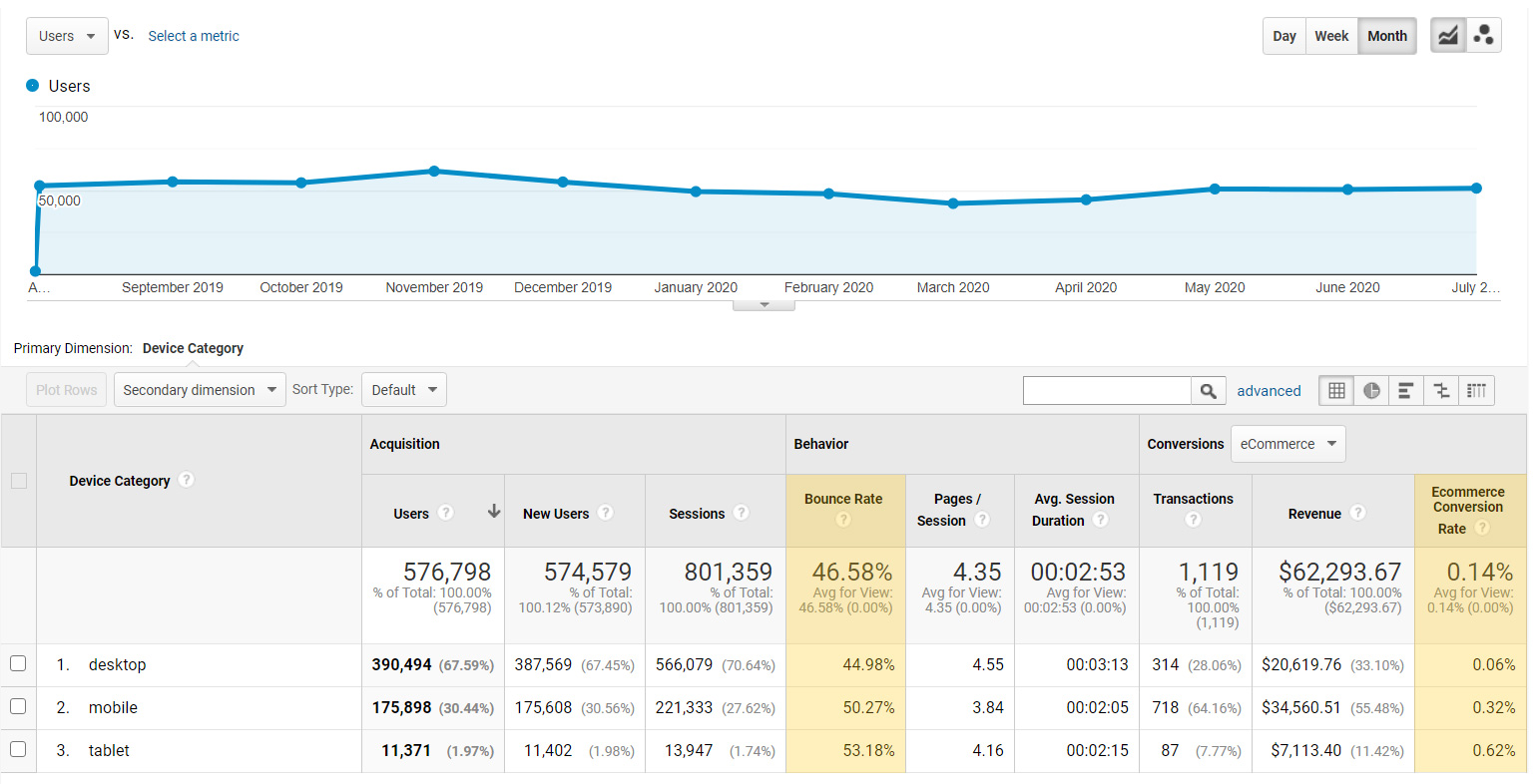
Check whether conversion rates are significantly lower for a certain device type. This may warrant further investigation. If your site does not measure conversion rates, check whether there is a significant difference in bounce rates across device types.
Log details in a tabular format which should help provide focus for your device testing efforts.
| Traffic percentage | Conversion rate | Bounce rate | |
| Desktop | 67.6% | 0.06% | 44.9% |
| Mobile | 30.4% | 0.32% | 50.3% |
| Tablet | 2% | 0.62% | 53.1% |
Next, test your home page and major landing pages on a variety of desktop, laptop, tablet and mobile devices. Try to include a range of operating systems in your testing (such as Windows and Mac laptops, as well as both iOS and Android phones).
Hint: Don’t forget to change the resolution on laptop devices to see whether any display issues arise on very large or very small screen resolutions, and remember to test tablet views in both landscape and portrait modes.
While testing, keep these questions in mind:
- Does the site render well across devices? Do you notice any design or functionality discrepancies?
- Are CTAs and tap targets easy to click on smaller devices?
- Are assets such as images, videos, charts and tables displaying correctly on all devices?
- Do headings and design elements wrap elegantly when the screen size changes?
Log any design and functionality issues for your developers to resolve.
Tip: You can use Google’s Mobile-Friendly Testing Tool to make a note of additional mobile display issues that the search engine has picked up.
Browser testing
Once you have tested your site on major device classes, it is time to run your site through a series of browser checks. This is especially important if it has been a few years since your last website refresh. Access Google Analytics (Audience > Technology > Browser & OS) and make a note of traffic breakdown, conversion rates and bounce rates across your top browsers e.g.:
| Traffic percentage | Conversion rate | Bounce rate | |
| Chrome | 52% | 1.63% | 44.6% |
| Safari | 38% | 1.62% | 39.9% |
| Firefox | 3% | 1.68% | 55.7% |
| Internet Explorer | 2% | 0.12% | 88.5% |
In the example above, Internet Explorer users have a significantly lower conversion rate and significantly higher bounce rate – this may indicate display or functionality issues with the user experience in that browser. Focus your browser testing efforts on browsers with these types of outlier stats.
Hint: Tools like Browserling can help you run tests on additional browsers that you may not have access to.
Conclusion
That’s it for week 4 of your website review! The last portion of your audit will assess the risk profile of your site.
Week 5: Risk review

Now that your website audit is nearing completion, it is time to review your site from a risk perspective – in other words, how secure is the site from data breaches and litigation risks?
Conduct a security audit
With data breaches soaring in 2019 and 2020, it is important to be proactive when it comes to the security of your site. A site security audit should look at issues such as the following:
- Does the site have a valid SSL certificate installed?
- Is your site protected from brute force attacks? In other words, does your site deny access to restricted content after a certain number of failed login attempts?
- Does your site enforce strong passwords on all login accounts?
- Is your website vulnerable to SQL injection attacks and cross-site scripting (XSS)?
- Are your site’s Javascript libraries up-to-date?
Tools such as Upguard can highlight some security risks, but we recommend hiring third-party web security experts to run penetration tests on your site (also known as “ethical hacking”). If your site was developed more than a few years ago, it probably requires specific security-related updates.
Review privacy compliance

Next, review your site’s compliance with the latest privacy legislation in your region, such as GDPR, CCPA, ePrivacy Regulation, and others. A compliance audit with the help of legal counsel should tackle questions such as the following:
- Does your website manage cookie consent?
- Does your website have an up-to-date privacy policy and cookie policy?
- Are your site’s terms and conditions up-to-date?
- Are your data management processes compliant with GDPR / privacy legislation particular to your region?
Hint: We recommend DLA Piper’s Data Protection Handbook to give you an overview of privacy legislation per country.
Run an accessibility audit
Lastly, your website needs to be compliant with regional accessibility laws if you would like to protect it against an accessibility lawsuit. Please see our detailed post for an overview of web accessibility legislation around the world and related guidelines.
Conclusion
Phew! You’ve made it! Now that you have completed your five-week website review, you may have a robust list of issues to address with your web developers. Set priorities, timelines and budgets for each of the tasks identified as part of the audit.
If there is an overwhelming number of issues to address, it may be time to re-build your site from the ground up. Whatever the situation, keep testing, keep auditing and keeping improving your site – you should start to see steady improvements in site traffic and conversions!

Web specialize in web services for professional services firms. See examples below on how we can assist.

